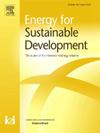Comparative Economic Analysis of Bifacial Roof-top PV Systems
IF 4.4
2区 工程技术
Q2 ENERGY & FUELS
引用次数: 0
Abstract
This study addresses the existing literature’s incomplete coverage of detailed LCOE (Levelised Cost of Electricity) and economic evaluation for bifacial photovoltaic (PV) systems. LCOE is a crucial metric in assessing the economic viability of energy generation. This paper introduces a novel model that captures the relationship between LCOE and the innovative technology of bifacial PV. It also analyzes the LCOE and energy payback period for an 8 kW bifacial PV plant, which is installed on the rooftop of the IIT Kharagpur campus. The LCOE derived from the real-time PV plant stands at 3.46 INR/kWh, while PVSyst predicts it as 3.37 INR/kWh. The corresponding payback period for the actual bifacial plant is approximately five years and five months, compared to five years and three months projected by PVSyst. It explicitly compares the economic feasibility of two rooftop PV systems: traditional monofacial panels and bifacial panels for scaled-up systems (1 MW). The analysis encompasses both systems’ initial costs, energy output, and payback periods. The findings reveal that the bifacial PV system outperforms the monofacial system in electricity generation and offers a shorter payback period. Consequently, the study demonstrates that the bifacial PV system represents a more economically advantageous choice for rooftop solar installations.
双面屋顶光伏系统的经济比较分析
现有文献对双面光伏(PV)系统的详细 LCOE(平准化电力成本)和经济评估覆盖不全,本研究针对这一问题进行了研究。LCOE 是评估能源发电经济可行性的重要指标。本文介绍了一种新型模型,该模型可捕捉 LCOE 与双面光伏创新技术之间的关系。它还分析了安装在印度理工学院卡拉格普尔校区屋顶的 8 千瓦双面光伏电站的 LCOE 和能源投资回收期。实时光伏电站的 LCOE 为 3.46 印度卢比/千瓦时,而 PVSyst 预测为 3.37 印度卢比/千瓦时。实际双面电站的相应投资回收期约为五年零五个月,而 PVSyst 预测的投资回收期为五年零三个月。它明确比较了两种屋顶光伏系统的经济可行性:传统的单面电池板和双面电池板放大系统(1 兆瓦)。分析包括两个系统的初始成本、能量输出和投资回收期。研究结果表明,双面光伏系统的发电量优于单面系统,投资回收期也更短。因此,该研究表明,双面光伏系统是屋顶太阳能装置中更具经济优势的选择。
本文章由计算机程序翻译,如有差异,请以英文原文为准。
求助全文
约1分钟内获得全文
求助全文
来源期刊

Energy for Sustainable Development
ENERGY & FUELS-ENERGY & FUELS
CiteScore
8.10
自引率
9.10%
发文量
187
审稿时长
6-12 weeks
期刊介绍:
Published on behalf of the International Energy Initiative, Energy for Sustainable Development is the journal for decision makers, managers, consultants, policy makers, planners and researchers in both government and non-government organizations. It publishes original research and reviews about energy in developing countries, sustainable development, energy resources, technologies, policies and interactions.
 求助内容:
求助内容: 应助结果提醒方式:
应助结果提醒方式:


